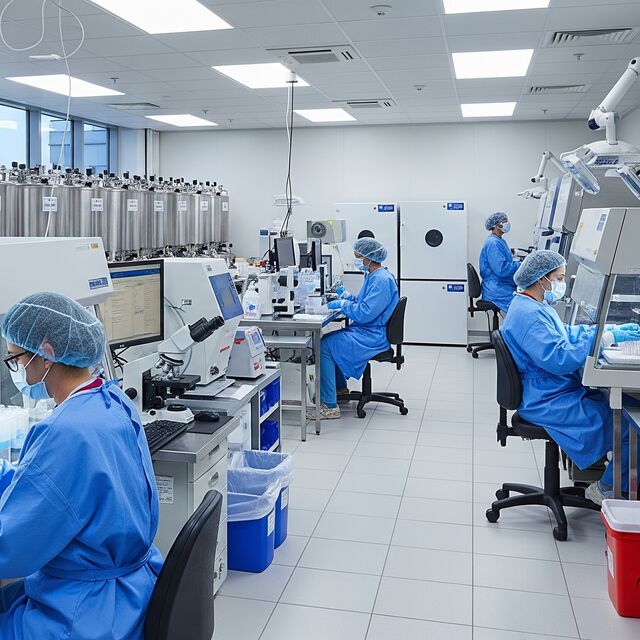Cost Guide: Cord Blood and Tissue Banking Explained
Key Takeaways
Cord blood and tissue banking can be a significant investment for families. Private banking, which guarantees family access, typically has upfront fees ranging from $1,500 to $3,000 and annual storage fees of $150 to $300 (in some cases). In contrast, public banking is free, but access to the stored cells is not guaranteed. Many private banks offer different payment options and long-term plans to help manage these costs.Options in Cord Blood Banking: Public or Family?
Expectant parents face a key decision regarding their baby’s cord blood: whether to donate it to a public bank or store it privately for their family’s exclusive use. This choice involves considering the purpose, cost, and accessibility of the stored stem cells.
Public cord blood banking is a donation-based, no-cost option. The donated cord blood is made available to any patient in need of a stem cell transplant, similar to a public blood bank. While donating is free, the family relinquishes all rights to the cord blood, and there is no guarantee it will be available for their own use in the future. Donated cord blood units are rigorously screened and listed on national registries to help patients worldwide find a life-saving match, particularly for those with diverse ethnic backgrounds who may have a harder time finding a donor.
Private cord blood banking, on the other hand, is a service where families pay to have their child’s cord blood collected, processed, and stored for their own exclusive use. This option provides a genetic match for the child and a likelihood of compatibility for siblings and other family members. Private banking is often chosen as a form of "biological insurance" to ensure a family has a readily available stem cell source for potential future medical needs, including both FDA-approved treatments and participation in clinical trials for conditions like cerebral palsy or autism. The primary drawback is the significant cost, which includes initial fees and ongoing annual storage charges.
One-Time Costs
The initial costs for cord blood and tissue banking involve significant upfront expenses. These cover the collection, processing, and preservation of your baby's stem cells.
Sample Collection and Processing
The processing fee includes several essential steps:
| Processing Component | Details |
|---|---|
| Collection Materials | Sterile tools and a specialized collection kit |
| Laboratory Work | Procedures for separating and isolating cells |
| Quality Testing | Screening and viability checks |
| Cryopreservation | Freezing and preparing samples for storage |
Storage Price Comparison
Beyond annual fees, overall pricing can differ based on factors like processing methods, facility quality, and service bundles. Americord Registry structures its costs based on storage duration and service combinations:
- Initial processing fees range from $1,500 to $3,000.
- Annual storage costs fall between $150 and $300 (in some cases).
- Multiple plan options are available, including 20-year and lifetime storage plans.
Most providers also offer flexible payment options, like one-time payments or 12-month installments, making it easier to manage costs. Pricing is subject to change. For the most up-to-date information, visit the Americord pricing page.
Cost-Benefit Analysis
Deciding whether to store cord blood and tissue involves balancing the potential medical advantages against the financial commitment. Knowing how often these resources are used and their treatment applications can help families decide if this option fits their needs.
Usage Statistics and Treatment Options
Cord blood stem cells have been used in over 50,000 transplants worldwide to treat more than 80 conditions, including childhood cancers, leukemias, lymphomas, blood disorders, hereditary immune deficiencies, and metabolic conditions.
These insights are essential when comparing the costs of private and public banking options.
Private vs. Public Banking
Private and public banking differ in cost, access, and treatment options. Here's a quick comparison:
| Aspect | Private Banking | Public Banking |
|---|---|---|
| Initial Cost | $1,500–$3,000 | Free donation |
| Annual Storage | $150–$300 | No cost |
| Access | Guaranteed family access | No guaranteed access |
| Treatment Options | FDA-approved treatments + experimental trials | Limited to FDA-approved treatments |
| Stem Cell Release Cost | Included in fees | Around $30,000+ |
“This is a medical service that has to be done when your baby's cells arrive, and you certainly want them to be handled by good equipment and good technicians. It's just not going to be cheap.”
Budgeting for Banking
If you decide to bank cord blood, planning ahead can help manage the costs. Here are some strategies:
- Start Early: Begin planning between weeks 28–34 of pregnancy to take advantage of flexible payment plans, bundled services, and potential discounts.
- Check Insurance: Insurance rarely covers cord blood banking, but financial assistance might be available if your family has a documented medical need.
- Optimize Costs: Look for multi-service bundles, compare long-term storage plans to annual payments, and evaluate the bank's processing methods and technologies.
Conclusion
Cost Summary
Private cord blood and tissue banking involves a notable financial commitment. Here’s a quick breakdown of typical costs:
| Cost Component | Typical Range | Details |
|---|---|---|
| Initial Processing | $1,500–$3,000 | One-time fee for collection, processing, testing |
| Annual Storage | $150–$300 | Depends on provider and included services |
| Material Costs | $250-$400 | Required for secure transportation |
| Release for Treatment | Included in fees | Costs are generally covered within the overall pricing structure |
“What I tell parents is, this is a choice - and you should make an informed choice.”
- Dr. Sergio Giralt, immediate past president of the American Society for Blood and Marrow Transplantation (ASBMT)
While private banking offers various payment plans, it’s essential to weigh the costs against your family’s needs.
The American Academy of Pediatrics advises private cord blood banking only when there’s a sibling with a medical condition treatable by cord blood transplantation. For families without specific medical reasons, public banking is a no-cost alternative that supports the wider community. However, it's critical to remember that stem cells will not be readily available for your family if you choose to do private cord blood banking.
Carefully considering all factors will help you make the best decision for your family.




